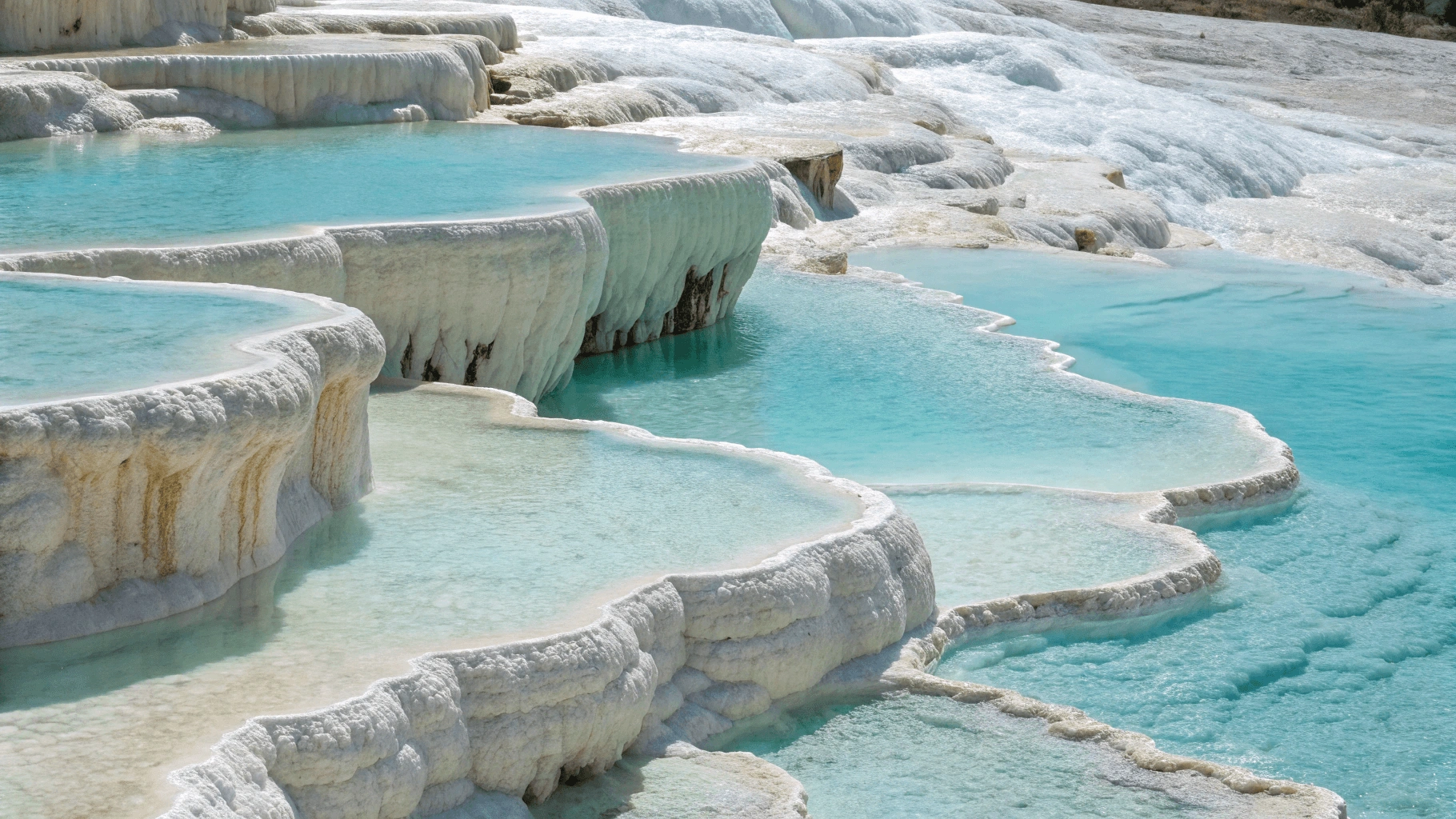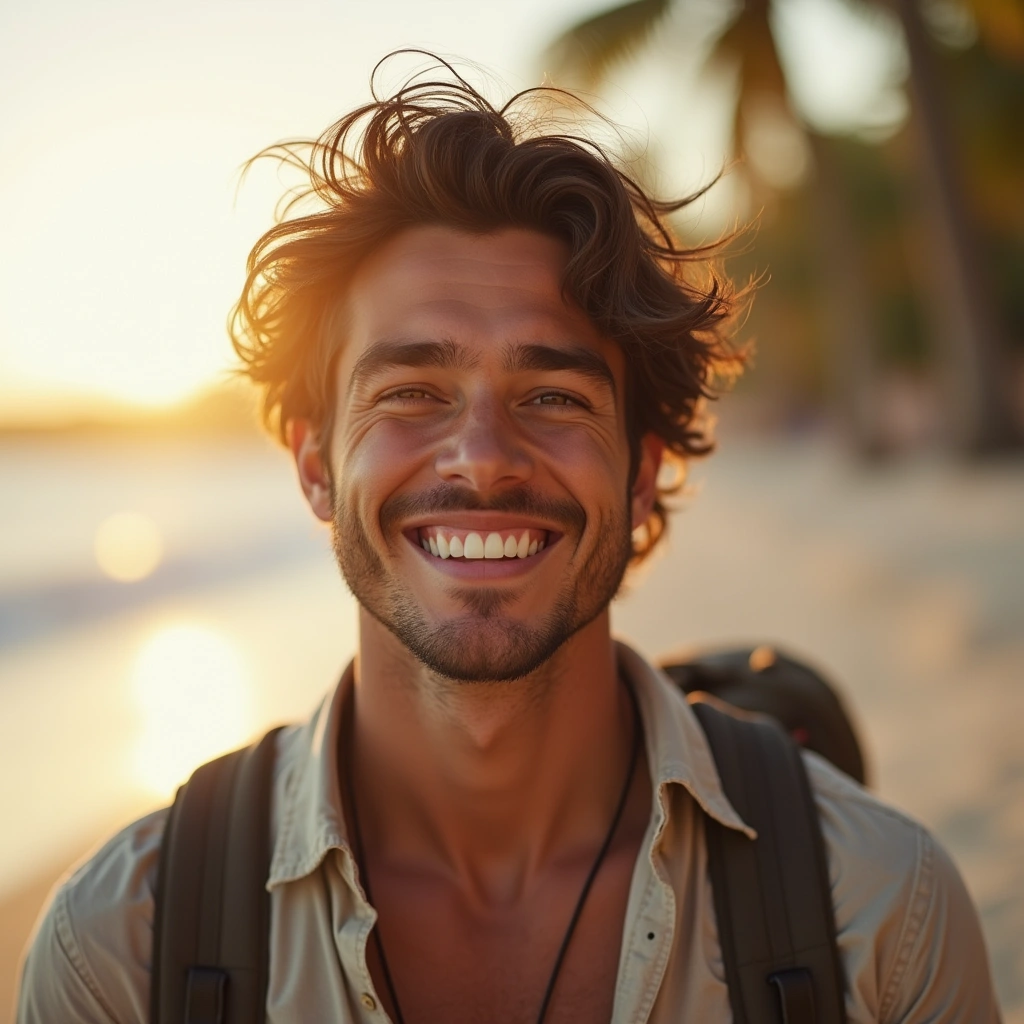Imagine standing before a series of cascading pools, their waters glowing with an otherworldly turquoise brilliance that seems almost artificial against the rugged Andean landscape. The Andean highlands, where Millpu is located, are part of a vast mountain range rich in biodiversity and culture (learn more from Britannica). The sun catches each ripple, transforming the surface into a mosaic of blue, aquamarine, and jade that shifts with every passing cloud. This isn’t a photoshopped mirage—this is Millpu, Peru’s best-kept natural secret.
The Baths of Millpu (or Aguas Turquesas de Millpu) are a stunning collection of natural travertine pools formed over centuries through mineral deposits in the Peruvian highlands. Unlike their more famous cousins in Pamukkale, Turkey, or Huanglong, China, these pristine formations remain relatively undiscovered by mass tourism, offering visitors a rare glimpse of untouched natural beauty in the remote Ayacucho region of Peru.
What makes these pools worth the journey? Beyond their jaw-dropping beauty, the Baths of Millpu offer an authentic experience away from Peru’s well-trodden tourist trail. While Machu Picchu sees thousands of daily visitors, Millpu provides a tranquil alternative where nature’s artistry can be appreciated in relative solitude.
Located in the Andean highlands of Peru’s Ayacucho region, approximately 3,500 meters above sea level, these natural wonders are accessible as a day trip from the city of Ayacucho. The best time to visit is during the dry season when the waters display their most vibrant colors, though getting there requires some planning and preparation.
Table of Contents
What Exactly Are the Baths of Millpu (Aguas Turquesas)?
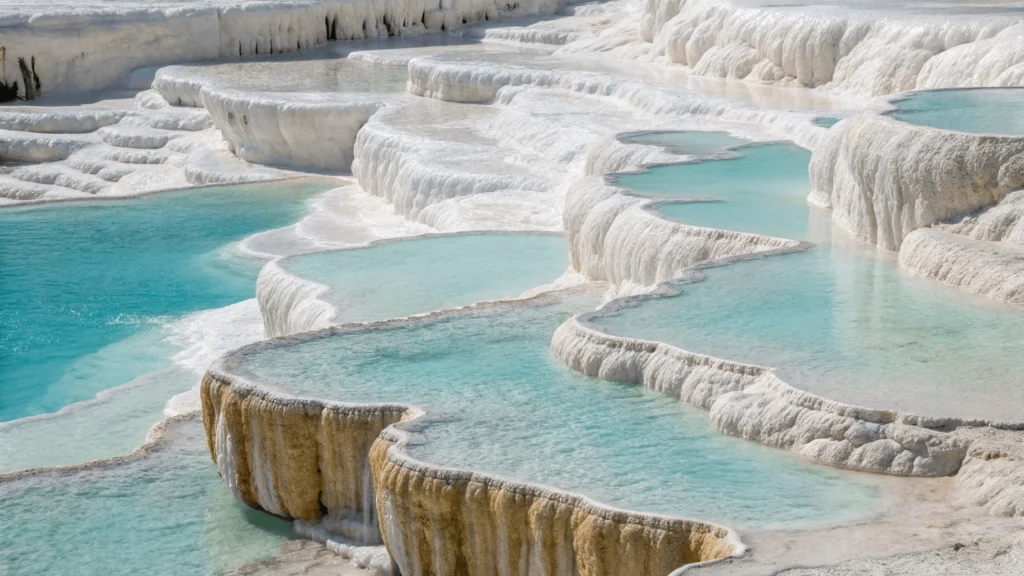
The Baths of Millpu are a geological marvel created through a fascinating natural process. Over thousands of years, calcium carbonate and other minerals dissolved in the water have gradually precipitated to form travertine terraces and dams. As water flows over these natural barriers, it creates a series of stepped pools with the distinctive turquoise coloration coming from the high mineral content reflecting light in unique ways.
Locally known as “Aguas Turquesas de Millpu,” these pools hold cultural significance for nearby communities, including the village of Circamarca. The name “Millpu” comes from Quechua, the indigenous language of the Andes, Quechua remains widely spoken in Peru today and is recognized as an official language alongside Spanish (Ethnologue report on Quechua). though the exact translation varies depending on local dialects.
It’s important to understand that Millpu isn’t just a single pool but rather an extensive network of cascading terraces and pools that stretch along a section of river valley. Each pool has its own character, depth, and particular shade of blue-green, creating a natural mosaic that changes with the seasons and lighting conditions.
Where are the Baths of Millpu Located?
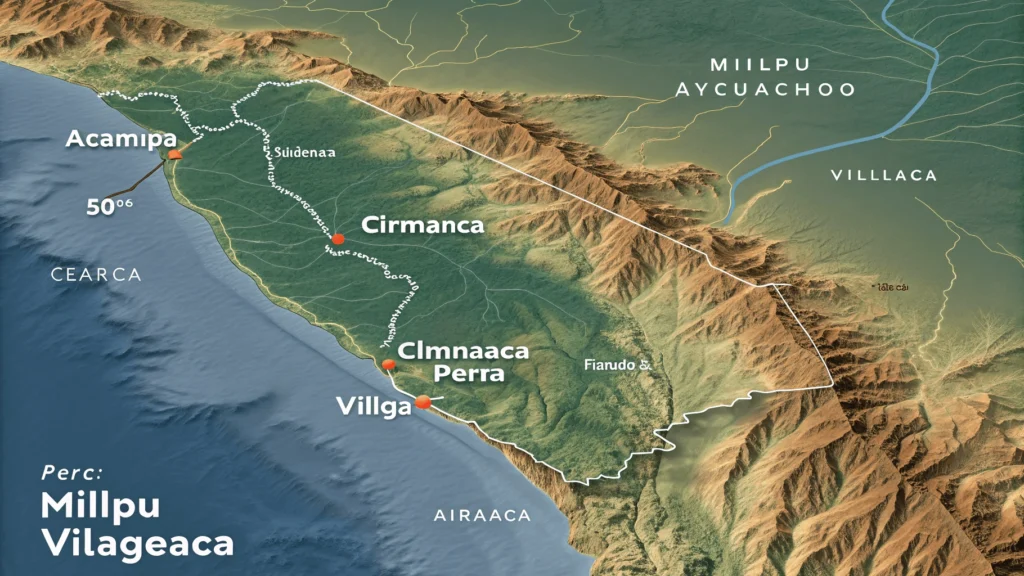
The Baths of Millpu are situated in the Ayacucho region of Peru, in the south-central Andes. This region lies roughly halfway between Lima and Cusco but remains far less visited than either destination. Ayacucho itself is known for its colonial architecture, artisanal traditions, and as the site of important historical events in Peru’s history.
The high altitude has several implications for visitors. The air is thinner, temperatures fluctuate dramatically between day and night, and the sun’s rays are more intense. These factors all necessitate proper preparation before visiting, especially for those not accustomed to high-altitude environments.
Best Time to Visit Millpu for Peak Turquoise Waters
Ideal Season: Dry Season (May – October)
For the most vivid turquoise waters and optimal visiting conditions, plan your trip during Peru’s dry season, between May and October. During these months, several factors combine to create the perfect Millpu experience:
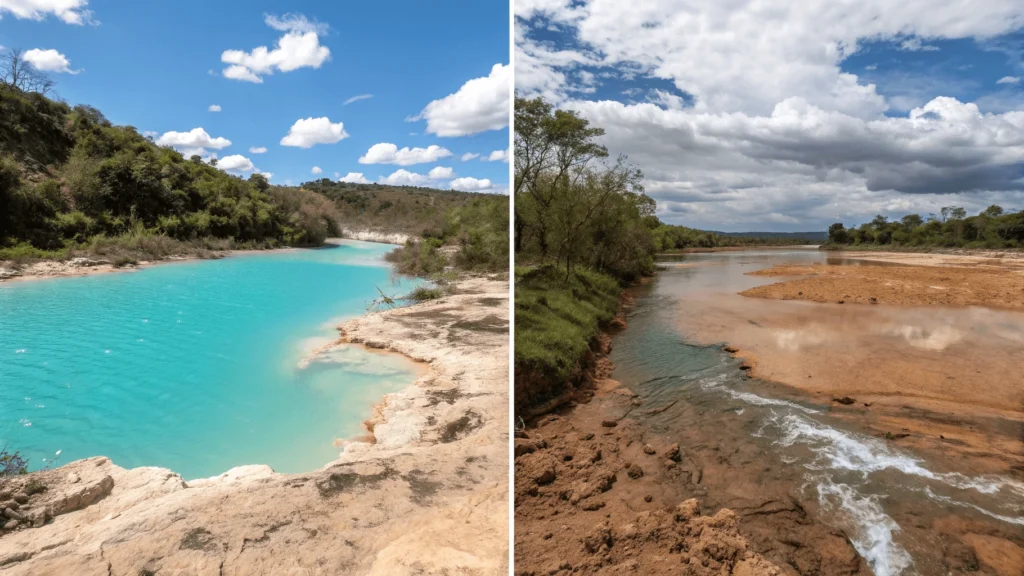
- Minimal rainfall means the water remains clear rather than muddy
- Stable weather patterns make the journey more predictable
- Trails are drier and easier to navigate
- The brilliant blue colors reach their peak intensity, particularly in June-August
- The contrast between the azure waters and the surrounding landscape is most dramatic
During the dry season, especially July and August, the pools often display their most vibrant coloration due to higher mineral concentration and optimal sunlight conditions.
Shoulder Seasons (April, November)
Visiting during the shoulder months of April or November presents a mixed proposition:
Pros:
- Fewer fellow travelers
- Potentially lower prices for transportation and tours
- Less crowded photos without other visitors in the background
Cons:
- Increased chance of rain that could affect water clarity
- More variable weather conditions
- Potential trail muddiness or difficult terrain
If you choose these months, monitor weather forecasts closely in the days leading up to your visit and be prepared to adjust plans if conditions deteriorate.
Rainy Season (December – March)
Not recommended. During Peru‘s rainy season from December through March, visiting Millpu becomes problematic for several reasons:
- Heavy rainfall turns the normally clear turquoise waters murky and brown
- Access roads can become impassable due to mud or washouts
- The trail to the pools becomes slippery and potentially dangerous
- Tours may be canceled without notice due to unsafe conditions
- The photogenic quality that makes Millpu special is largely absent
If Millpu is your primary reason for visiting the Ayacucho region, avoid planning your trip during these months. The reality rarely matches expectations or photographs from the dry season.
Time of Day
For photography enthusiasts, mid-morning to early afternoon (around 10 AM to 2 PM) typically provides the best lighting conditions. During these hours, the sun’s position maximizes the turquoise effect as light penetrates the mineral-rich waters. Early morning visits may find the pools in shadow from surrounding hills, while late afternoon light can create unwanted reflections or dull the vibrant colors.
How to Get to Millpu: Tours vs. Independent Travel
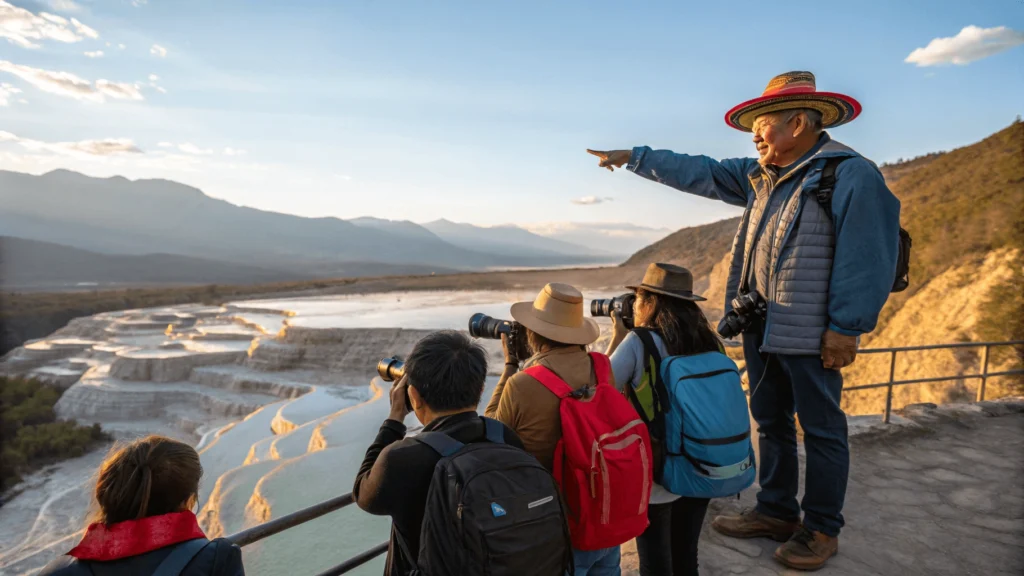
Option 1: Organized Tours from Ayacucho (Most Common)
For most visitors, especially those with limited time or Spanish language skills, organized tours represent the most straightforward way to experience Millpu.
Pros:
- Door-to-door transportation from Ayacucho city
- Guide services included (usually Spanish, sometimes English)
- All entrance fees and logistics handled for you
- Fixed itinerary removes guesswork
- Safety in numbers on remote roads
Cons:
- Limited time at the actual pools (typically 1-2 hours)
- Fixed schedule with predetermined photo stops
- Group dynamics can affect your experience
- Less flexibility for exploration
What to Expect: Most tours follow a similar formula:
- Early morning pickup from Ayacucho accommodations (around 6-7 AM)
- 2.5-3 hour drive to Circamarca village
- Brief stop in Circamarca to register and pay entrance fees
- Guided walk to the Millpu pools (30-45 minutes)
- 1-2 hours at the pools for photography and exploration
- Return walk and lunch (sometimes included, sometimes at additional cost)
- Return to Ayacucho, arriving by early evening (5-7 PM)
Tours typically cost between 80-120 PEN (approximately $22-33 USD) per person, with variations based on group size, inclusions, and operator. Some premium options might include professional photography assistance or more extensive meals.
How to Choose a Tour Operator:
- Check recent reviews on platforms like TripAdvisor or Google Maps
- Confirm exactly what’s included (transportation, entrance fees, food)
- Ask about group size (smaller groups generally mean more time at the pools)
- Verify the language your guide will speak
- Ask about cancellation policies in case of bad weather
Option 2: Independent Travel (For the Adventurous)
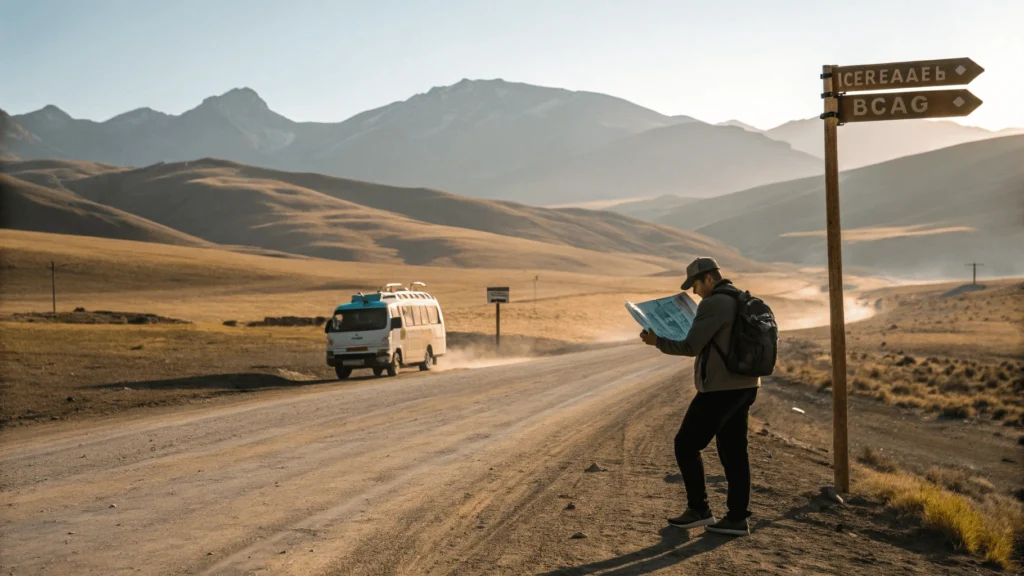
For travelers comfortable with logistics challenges and with at least basic Spanish skills, independent travel to Millpu is possible but requires significantly more effort.
Challenge Level: Moderate to Difficult
This option is recommended only for experienced travelers comfortable with rural Peruvian transportation and some Spanish communication skills. The route is not well-signed, and few locals along the way speak English.
Step 1: Ayacucho to Circamarca
- Public Transport Option: Take a colectivo (shared van) from Ayacucho’s Terminal Terrestre to Andahuaylas, asking to be dropped at the Circamarca turnoff. These depart when full, usually between 5-9 AM. Cost: approximately 25-30 PEN ($7-8 USD). Journey time: 2-2.5 hours.
- From the highway turnoff, you’ll need to walk approximately 4km uphill to Circamarca or negotiate with a local driver for transport if available (not guaranteed). This walk takes about 45-60 minutes.
- Private Taxi Option: Negotiate with a taxi in Ayacucho for round-trip service. Expect to pay 150-250 PEN ($40-70 USD) for the entire day, depending on your negotiation skills and how long the driver will wait.
Step 2: Circamarca to Millpu Entrance
- In Circamarca, you must register and pay the entrance fee (approximately 10 PEN or $3 USD)
- From the village center, follow the marked trail toward Millpu (ask locals if unsure)
- The walk from Circamarca to the pools takes approximately 30-45 minutes on a gradually descending path
Pros:
- Complete flexibility with timing
- Opportunity for longer photography sessions
- Potential to arrive before or after tour groups
- More authentic local interaction
- Potentially lower overall cost for groups of 3+
Cons:
- Time-consuming logistics
- Language barrier challenges
- Uncertain transportation schedules
- Need to arrange return transportation
- Limited food and water options
Crucial DIY Tips:
- Start your journey from Ayacucho no later than 6 AM to ensure ample time at the pools
- Confirm the latest colectivo return times to Ayacucho before leaving Circamarca
- Carry more cash than you think you’ll need (no ATMs available)
- Download offline maps as cell service is limited
- Consider arranging a private driver for the entire day if your budget allows
- Pack all necessary food, water, and supplies
What to Expect on Your Visit: The Millpu Experience
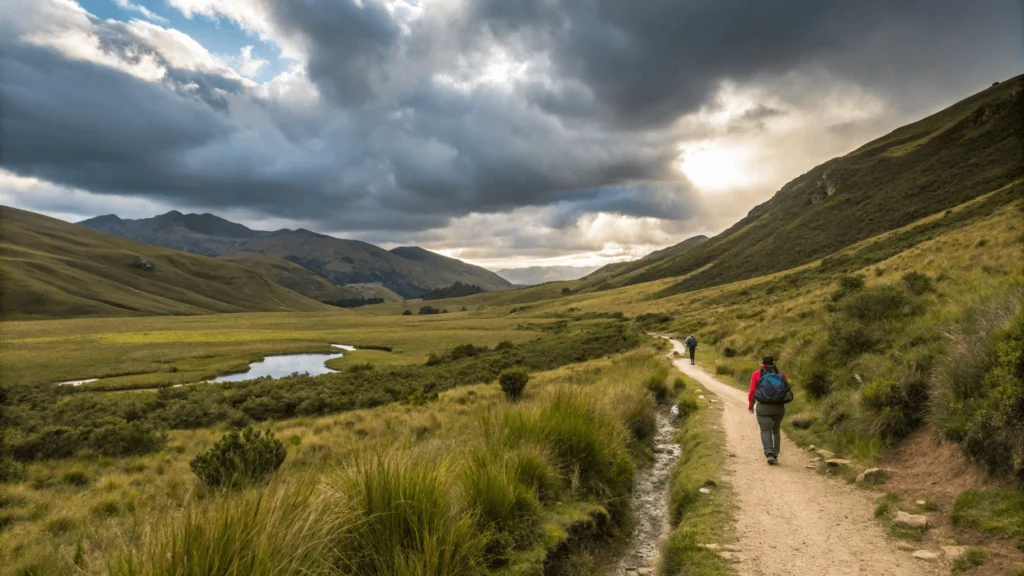
The Trail
From the registration point near Circamarca, a relatively gentle trail leads to the Millpu pools. The path descends gradually through typical Andean highland landscape with these characteristics:
- Mostly dirt path with some rocky sections
- Approximately 2.5 kilometers (1.5 miles) one-way
- 30-45 minute walk for most visitors at a moderate pace
- Minimal elevation change, but remember you’re already at high altitude
- Several viewpoints along the way offering panoramic vistas
- Limited shade, so sun protection is essential
The trail is not technically difficult but requires sturdy footwear due to uneven terrain. Those with significant mobility issues may find it challenging as there are no handrails or improved surfaces.
The Pools
Upon arriving at Millpu, visitors are greeted by a series of cascading pools that vary in size, depth, and color intensity:
- Upper pools tend to be smaller but often display the most intense turquoise coloration
- Middle section features the most photogenic cascades with multiple levels
- Lower pools are generally larger but sometimes less vibrantly colored
- The entire formation stretches approximately 500 meters along the valley
The color intensity varies throughout the day as the sun’s position changes, with mid-day typically offering the most striking visual impact as sunlight penetrates the mineral-rich waters.
Swimming Rules (CRITICAL)
Important: Swimming is strictly prohibited in the main turquoise pools.
This rule exists to preserve the delicate mineral formations and water clarity. The oils from human skin, sunscreen, and other contaminants can permanently damage the travertine formations and alter the water chemistry that creates the distinctive coloration.
Some visitors report that local guides occasionally identify small, separate pools downstream where limited wading is permitted, but this should never be assumed and always verified with current official guidance. The regulations are enforced by local custodians who patrol the area, and violations can result in fines or being asked to leave.
Respecting these preservation measures ensures that future visitors can enjoy this natural wonder in its pristine state.
Facilities
Millpu’s remote location means very limited infrastructure for visitors:
- Basic toilet facilities exist near the entrance point (bring your own toilet paper)
- No trash cans along the trail or at the pools (pack out everything you bring)
- No food vendors at the pools themselves
- Small food stalls sometimes operate in Circamarca village with basic snacks
- No potable water sources (bring all you’ll need)
The lack of development is part of what keeps Millpu special, but it requires visitors to be self-sufficient and prepared.
Crowds
Despite being less known than other Peruvian attractions, Millpu has gained popularity in recent years:
- Weekends can see 5-10 tour groups arriving throughout the day
- During peak season (July-August), expect to share viewpoints with others
- Weekday visits, especially early mornings, offer more solitude
- Peruvian holidays and long weekends bring domestic tourists
For the best experience with minimal crowds, aim for a mid-week visit during shoulder season and arrive early in the day before most tour groups.
Essential Packing List for Millpu
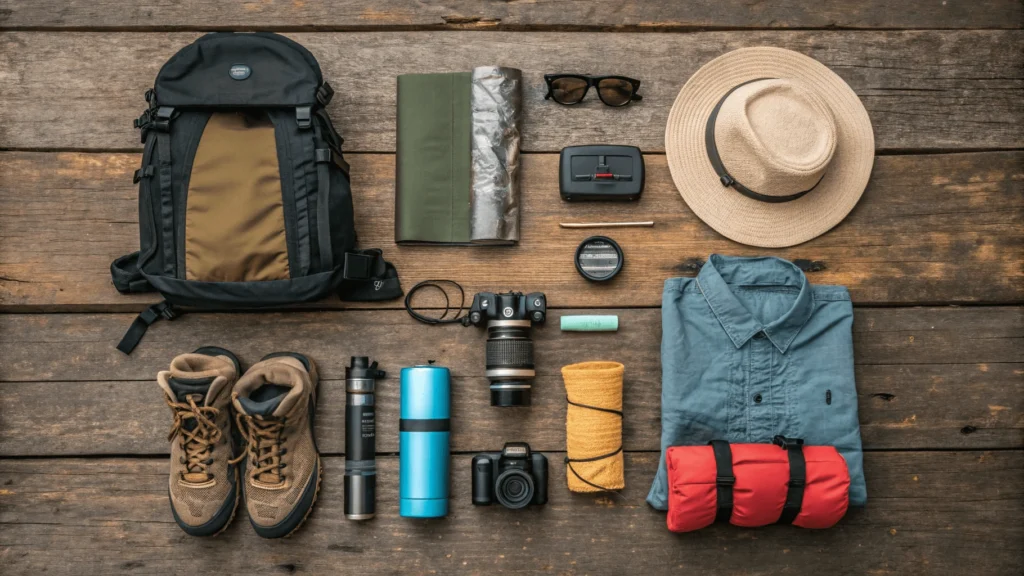
Proper preparation is crucial for enjoying your visit to these remote high-altitude pools. Be sure to bring:
Clothing
- Layered Clothing: Temperatures at 3,500m can shift dramatically throughout the day
- Waterproof/Windproof Jacket: Protection from unexpected weather changes
- Hat with Brim: For sun protection at high altitude
- Quick-Dry Clothing: In case of light rain or spray from the pools
Footwear
- Hiking Shoes or Boots: The trail has uneven, sometimes slippery sections
- Spare Socks: In case yours get wet during stream crossings
Sun Protection
- High SPF Sunscreen (50+): UV radiation is significantly stronger at high elevation
- Sunglasses: Preferably polarized to reduce glare from water
- Lip Balm with SPF: Often forgotten but essential
Hydration & Nutrition
- Water Bottle(s): At least 1.5 liters per person
- Snacks/Lunch: Energy-dense foods like nuts, dried fruits, sandwiches
- Electrolyte Supplements: Helpful for altitude adjustment
Photography & Documentation
- Camera: With fully charged batteries (no charging opportunities)
- Extra Memory Cards: The scenery is extremely photogenic
- Protective Case: To shield electronics from potential moisture
- Small Towel: To dry equipment if needed
Money & Documents
- Cash (PEN): No card facilities available (200-300 soles recommended)
- ID/Passport Copy: May be required at registration
- Printed Tour Confirmation: If applicable
Health & Safety
- Basic First-Aid Kit: Including blister treatment and pain relievers
- Altitude Sickness Remedies: Coca leaves, altitude medication if prescribed
- Hand Sanitizer: Limited washing facilities available
- Toilet Paper: Not provided at facilities
- Plastic Bags: For packing out all trash
Optional Items
- Trekking Poles: For added stability on uneven terrain
- Binoculars: For wildlife spotting and distant views
- Small Cushion: For comfortable seating during breaks
- Lightweight Packable Towel: In case wading is permitted in designated areas
Costs and Fees for Visiting Millpu (2025 Estimates)
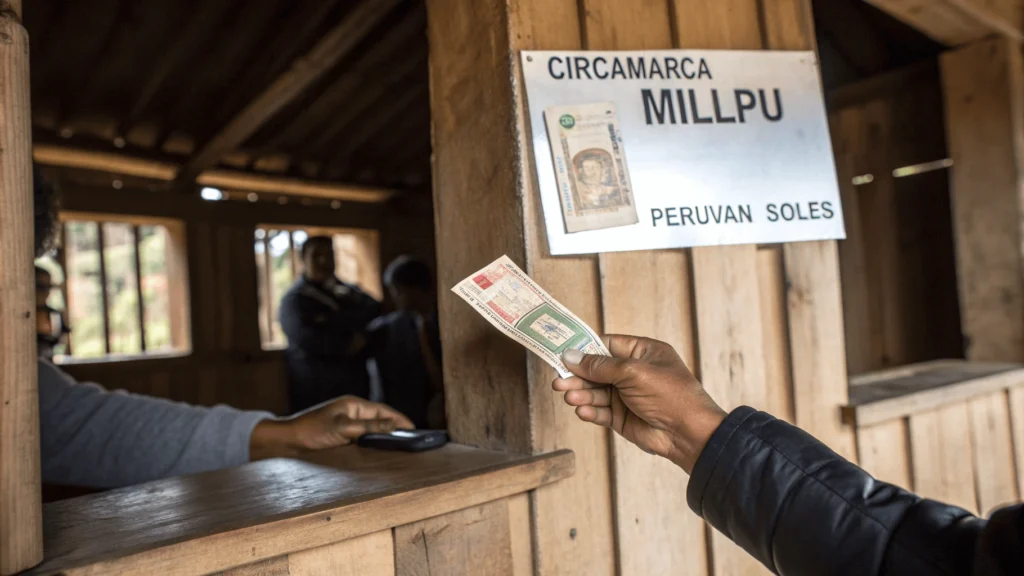
Planning your budget for Millpu involves several components:
Entrance Fee
- Individual entrance to Millpu: 10-15 PEN ($3-4 USD) per person
- Sometimes collected in Circamarca, sometimes at a checkpoint near the pools
- Fees may be slightly higher during peak season or holidays
Tour Costs (If Applicable)
- Standard day tour from Ayacucho: 80-120 PEN ($22-33 USD) per person
- Premium tours with additional services: 120-200 PEN ($33-55 USD)
- Private tours: Starting around 250-400 PEN ($70-110 USD) per person, decreasing with larger groups
Independent Transport Costs
- Colectivo from Ayacucho to Circamarca turnoff: 25-30 PEN ($7-8 USD) each way
- Private taxi (round trip with waiting time): 150-250 PEN ($40-70 USD) total
- Local transport from highway to Circamarca (if available): 5-10 PEN ($1.50-3 USD)
Food & Miscellaneous
- Basic lunch at local eatery: 10-15 PEN ($3-4 USD)
- Snacks and water in Ayacucho: 15-25 PEN ($4-7 USD)
- Emergency funds: Recommended to carry an extra 100 PEN ($28 USD)
Total Budget Estimate
- Tour Option: 100-150 PEN ($28-42 USD) per person (all-inclusive)
- Independent Option: 70-120 PEN ($20-33 USD) per person (depending on transport choices)
All prices are approximate and subject to change. Local holidays or events may affect pricing and availability.
Photography Tips for Capturing Millpu’s Beauty
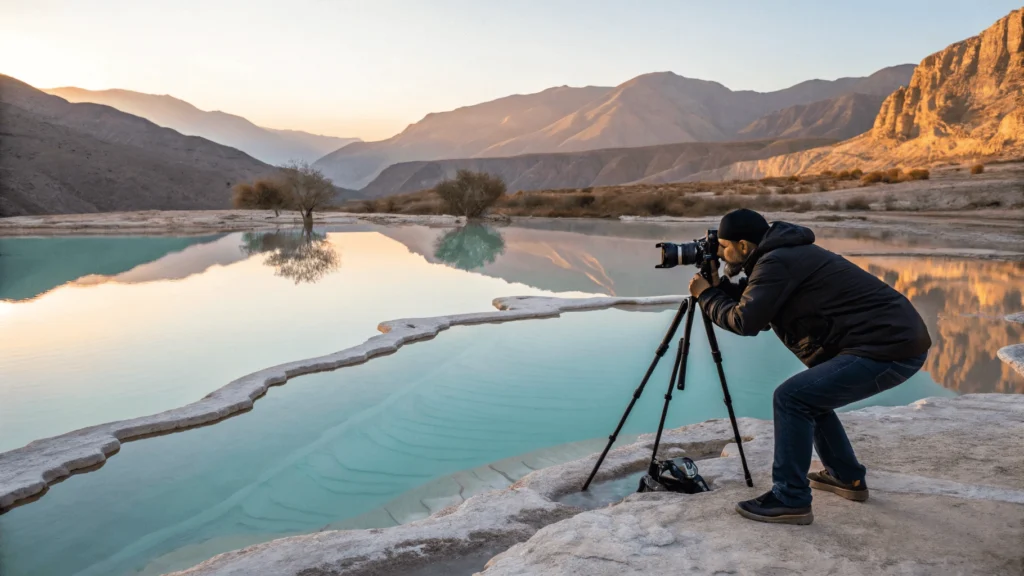
The extraordinary colors and formations of Millpu make it a photographer’s paradise, but capturing its true essence requires some preparation and technique.
Lighting Considerations
- Prime Hours: 10 AM to 2 PM typically provides the most vibrant colors
- Avoid Early Morning: Shadows from surrounding hills can obscure the pools
- Weather Impact: Slight overcast can actually enhance color saturation by reducing harsh reflections
Composition Strategies
- Leading Lines: Use the natural flow of the cascades to draw the eye through your frame
- Scale References: Including a person (with permission) can demonstrate the size of the pools
- Multiple Levels: Capture the terraced nature by showing several pools in one frame
- Reflections: Look for still pools that mirror the surrounding landscape
- Varying Perspectives: Try shooting both wide landscape views and intimate details of the mineral formations
Equipment Recommendations
- Wide-Angle Lens: Essential for capturing the broader landscape (16-35mm equivalent)
- Polarizing Filter: Reduces glare on water surfaces and enhances color saturation
- Neutral Density Filter: Useful for longer exposures to smooth water movement
- Tripod: Stabilization for longer exposures or low-light conditions
- Lens Cloth: Keep optics clean from water spray and dust
Drone Photography
Important Update for 2025: Drone use at Millpu is currently restricted due to conservation concerns and local regulations. As of early 2025, permits are theoretically available but difficult to obtain in practice, requiring application several weeks in advance through the Ayacucho regional tourism office.
Flying without proper authorization risks confiscation of equipment and fines. If aerial photography is essential to your project, consider contacting local authorities well in advance of your visit to inquire about the current application process.
Practical Photography Tips
- Protect your gear from water spray, especially near cascades
- Bring extra batteries as charging opportunities are nonexistent
- Consider bracketing exposures for challenging light conditions
- Be respectful of other photographers and visitors waiting for unobstructed views
- Always ask permission before photographing local people
- Remember that the vibrant colors are natural—avoid over-saturating in post-processing for authentic representation
Altitude Sickness Awareness & Prevention
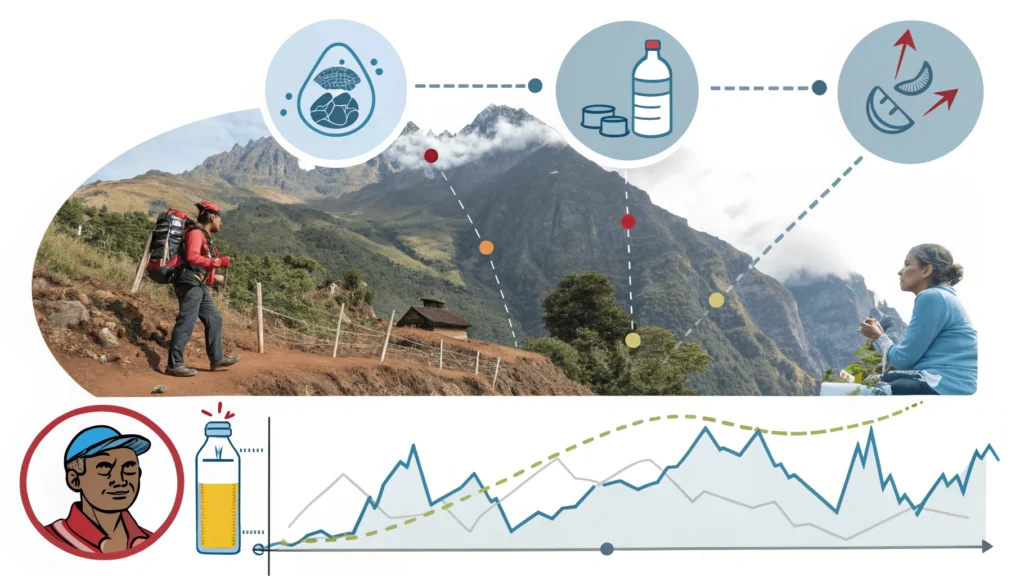
With elevations around 3,500 meters (11,500 feet), altitude sickness is a genuine concern for visitors to Millpu, especially those arriving directly from lower elevations like Lima.
Understanding Altitude Sickness
Altitude sickness (Acute Mountain Sickness or AMS) occurs when your body doesn’t have enough time to adapt to lower oxygen levels at high elevations. Symptoms can range from mild to severe and typically include:
- Headache (often the first symptom)
- Nausea or vomiting
- Dizziness or lightheadedness
- Fatigue or weakness
- Difficulty sleeping
- Shortness of breath during exertion
- Loss of appetite
Prevention Strategies
1. Acclimatization
- Spend at least 1-2 full days in Ayacucho (2,750m/9,000ft) before visiting Millpu
- If coming from Lima or other low-altitude locations, consider an intermediate stop
- Avoid flying directly to high altitude if possible
2. Hydration
- Drink significantly more water than usual (at least 3-4 liters daily)
- Limit alcohol consumption completely in the days before your visit
- Avoid caffeine which can contribute to dehydration
3. Medication Options (consult your doctor before travel)
- Acetazolamide (Diamox): Can be taken preventatively
- Over-the-counter pain relievers for symptom management
- Prescription medications for severe cases
4. Local Remedies
- Coca tea (mate de coca): Widely available and traditionally used for altitude adjustment
- Chlorophyll supplements: Some locals recommend these for oxygen efficiency
- Muna tea: Another local herbal remedy believed to help with altitude symptoms
5. Activity Modification
- Move slowly during your first days at altitude
- Take regular breaks during the walk to Millpu
- Avoid overexertion or rushing
- Consider postponing your visit if symptoms appear severe
When to Seek Medical Attention
Severe altitude sickness can be life-threatening. Seek immediate medical help if you experience:
- Severe headache unrelieved by medication
- Persistent vomiting
- Increasing shortness of breath at rest
- Confusion or disorientation
- Difficulty walking straight
- Persistent cough or pink/frothy sputum
The nearest medical facilities to Millpu are basic, with comprehensive care available only in Ayacucho city. For this reason, it’s essential to monitor symptoms carefully and return to lower elevation immediately if severe symptoms develop.
Responsible Tourism at Millpu

The increasing popularity of Millpu presents both opportunities and challenges for this fragile ecosystem and the local communities. As visitors, we have a responsibility to minimize our impact.
Environmental Stewardship
Leave No Trace Principles:
- Pack out everything you bring in—there are no trash facilities on site
- Stay strictly on marked trails to prevent erosion and vegetation damage
- Leave natural objects as you found them—no collecting rocks, plants, or other souvenirs
- Keep noise levels low to avoid disturbing wildlife
- Use biodegradable sunscreen if there’s any chance of water contact (even accidental)
Water Protection:
- Never enter pools where swimming is prohibited
- Avoid touching the water even from the edges—the oils from skin can damage mineral formations
- Keep a safe distance from pool edges to prevent accidental contamination
- Report any observed rule violations to guides or site custodians
Supporting Local Communities
Economic Participation:
- Purchase snacks, water, and supplies from shops in Circamarca rather than bringing everything from Ayacucho
- Consider hiring local guides in addition to or instead of city-based tour operators
- Pay fair prices without excessive haggling over small amounts
- Tip guides appropriately for good service (10-15% is customary)
Cultural Respect:
- Ask permission before photographing local people
- Learn a few basic phrases in Spanish or Quechua
- Respect local customs and traditions
- Dress modestly, especially when passing through communities
Conservation Awareness
Understanding why protection matters helps visitors become advocates for preservation:
The Millpu ecosystem is extraordinarily fragile. The calcium carbonate deposits that form the pools accumulate extremely slowly—often just millimeters per year. Damage from human contact can take decades or centuries to repair naturally. The chemicals in sunscreen, insect repellent, and even natural oils from human skin can disrupt the delicate chemical balance that creates the turquoise coloration.
By following regulations and practicing minimal-impact tourism, you help ensure this natural wonder remains intact for future generations.
Where to Stay in Ayacucho
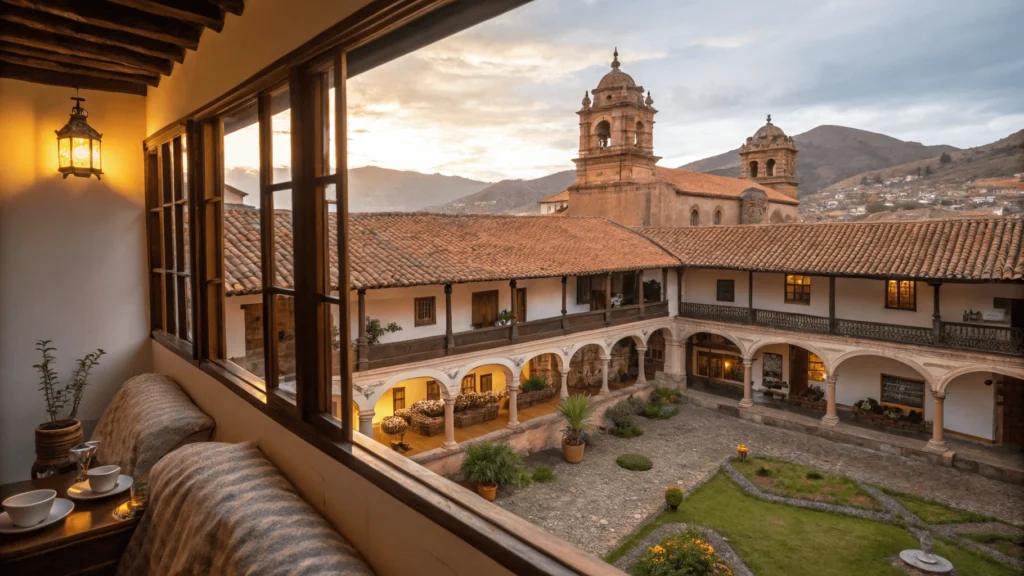
While Millpu itself has no accommodation options, the city of Ayacucho offers a range of places to stay for various budgets. Plan to base yourself here before and after your Millpu excursion.
Budget Options (30-80 PEN / $8-22 USD per night)
- Hostal Samay Wasi: Simple rooms with shared bathrooms near the central plaza
- Hostal Los Libertadores: Basic but clean accommodation with hot water
- Guest houses: Several family-run options with affordable rates
Mid-Range Options (80-200 PEN / $22-55 USD per night)
- Hotel Santa Rosa: Comfortable rooms in a colonial-style building
- Hotel Mariscal: Modern amenities with a central location
- Hotel De La Villa: Good value with included breakfast
Higher-End Options (200+ PEN / $55+ USD per night)
- Hotel Plaza Mayor: Superior rooms with colonial architecture
- Hotel Wayra: Contemporary design with excellent amenities
- Via Via Hotel: Boutique option with restaurant and cultural activities
Location Considerations
The most convenient areas to stay in Ayacucho include:
- Around Plaza de Armas: Central location, walking distance to restaurants and services, but can be noisy
- San Juan Bautista area: Slightly quieter neighborhood, still accessible to center
- Near Alameda Valdelirios: Pleasant area with parks and good restaurants
Most tour operators will pick up from any hotel within the central area of Ayacucho, but confirm this when booking if staying further out.
Frequently Asked Questions
Can you swim in the Baths of Millpu?
No, swimming is strictly prohibited in the main turquoise pools to preserve their unique formation and coloration. The minerals that create the distinctive color are extremely delicate, and oils from human skin, sunscreen, and other contaminants can permanently damage them. Occasionally, guides may identify small separate pools downstream where limited wading may be permitted, but never enter any pool without explicit permission from official guides or custodians.
How long is the Millpu tour?
A standard tour from Ayacucho typically takes a full day (10-12 hours total). This includes approximately 5-6 hours of round-trip transportation, 30-45 minutes walking each way to the pools, and 1-2 hours at the pools themselves. Independent travelers can extend their time at the pools but must consider transportation schedules for returning to Ayacucho.
Is Millpu worth visiting?
Absolutely. For travelers seeking extraordinary natural wonders off the typical tourist route, Millpu offers a unique experience that rivals more famous destinations. The combination of vibrant colors, remote setting, and relatively low visitor numbers creates a memorable experience not found at Peru’s more commercialized attractions. However, visitors should set realistic expectations about the journey involved and understand that weather conditions significantly impact the experience.
How difficult is the walk to Millpu?
The walk from Circamarca to the pools is moderate in difficulty. The trail covers approximately 2.5 kilometers (1.5 miles) with gentle elevation changes and takes 30-45 minutes each way for most visitors. The challenge comes primarily from the high altitude (approximately 3,500 meters/11,500 feet) rather than technical trail difficulty. Those with reasonable fitness levels and proper acclimatization should have no major problems, but the altitude makes the walk more strenuous than a similar distance at lower elevations.
Is Millpu worth visiting?
The Baths of Millpu sit at approximately 3,500 meters (11,500 feet) above sea level. This high-altitude environment means thinner air, stronger UV radiation, and greater potential for altitude sickness, especially for visitors coming directly from coastal areas. Proper acclimatization in Ayacucho (2,750 meters/9,000 feet) for at least 1-2 days before visiting Millpu is strongly recommended.
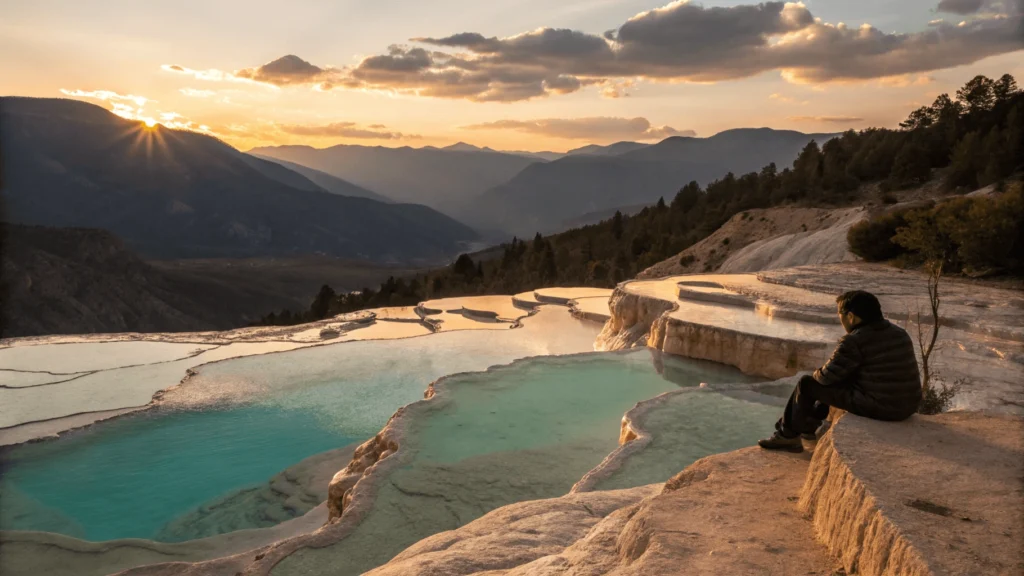
Conclusion
The Baths of Millpu represent Peru at its most authentically beautiful—a place where nature’s artistry shines without the infrastructure and crowds that characterize many of the country’s more famous destinations. The journey to reach these remote turquoise pools requires effort and planning, but those who make the trip are rewarded with an experience that few travelers can claim.
As tourism to this hidden gem gradually increases, responsible visitation becomes ever more important. By following local regulations, respecting the fragile ecosystem, and supporting local communities, we can help ensure that Millpu remains pristine for generations to come.
The combination of vibrant turquoise waters, dramatic Andean landscape, and the adventure of reaching this remote location creates memories that will last long after your visit. Whether you’re a photographer seeking extraordinary natural subjects, an adventurer looking to explore beyond the standard tourist circuit, or simply a traveler who appreciates natural wonders, Millpu deserves a place on your Peruvian itinerary.
Start planning your unforgettable trip to the Baths of Millpu today and discover why this hidden treasure is becoming known as one of South America’s most spectacular natural wonders!

